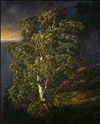November 6, 2005
Dahl
 Johan Christian Dahl (1788-1857) is the 'father' of Norwegian painting. He was the first Norwegian artist to gain international standing in his lifetime. He moved to Dresden in Germany in the 1820s. There he became a professor of art, and an important figure in the Romantic movement. He even lived in the same house as Caspar David Friedrich, the most significant painter in German romantic painting.
Johan Christian Dahl (1788-1857) is the 'father' of Norwegian painting. He was the first Norwegian artist to gain international standing in his lifetime. He moved to Dresden in Germany in the 1820s. There he became a professor of art, and an important figure in the Romantic movement. He even lived in the same house as Caspar David Friedrich, the most significant painter in German romantic painting.
Landscape painting before Romanticism was not held in high regard. The Romantics brought it to a new level. They dispensed with the unemotional, distant feeling of neoclassicism, and began to show the exciting drama of nature. This was influenced by philosophers who distinguished the 'beautiful' from the 'sublime'. Nature was sublime: a great power to gaze in awe upon.
Edmund Burke, in A Philosophical Enquiry into Our Ideas of the Sublime and the Beautiful (1757) defined the sublime as something that gives us delight at the same time as terrifying us, because it is physically more powerful than us. Immanuel Kant, in the Critique of Judgement (1790), defined the 'dynamic sublime' along the same lines as Burke's sublime, but distinguished it from the 'mathematical sublime', which he defined as something so huge we feel pain in our desire to comprehend it. This influenced Romantic artists like Dahl to paint human figures very small, in contrast to the majesty of nature. The Norwegian landscape, with its mountains and fjords, is particularly dramatic, and was the subject of Dahl's art. Even though he lived in Dresden, he was committed to depicting his homeland with pride, and he painted the Norwegian landscape mainly from memory.
But the Romantic period was also about a new consciousness of human freedom and brotherhood. Dahl depicted people in Norwegian national costume as part of the landscape. He was consciously celebrating his national culture. Norway, still ruled by Sweden at this time, had a growing national pride. Dahl's affection for his homeland is unquestionable. He was one of the founders of Oslo's National Gallery and donated his art collection to it.
The painting here, Bjerk i storm (Birch in Storm) from 1849, I saw in the Kunstmuseum in Bergen, and it is Dahl's most famous legacy. Through the influence of a fairly creative art critic, the young birch here came to be seen as a symbol for the nation of Norway, struggling defiantly against the storm of history. Viewed this way, the image outlives Dahl. Just think of the country when it was under the yoke of Nazi stormtroopers, and the symbol still holds. It's a Romantic and emotional notion.
Contact Me
Posted by barry at November 6, 2005 11:33 FM

post<li> - Post to Social Networking Sites
